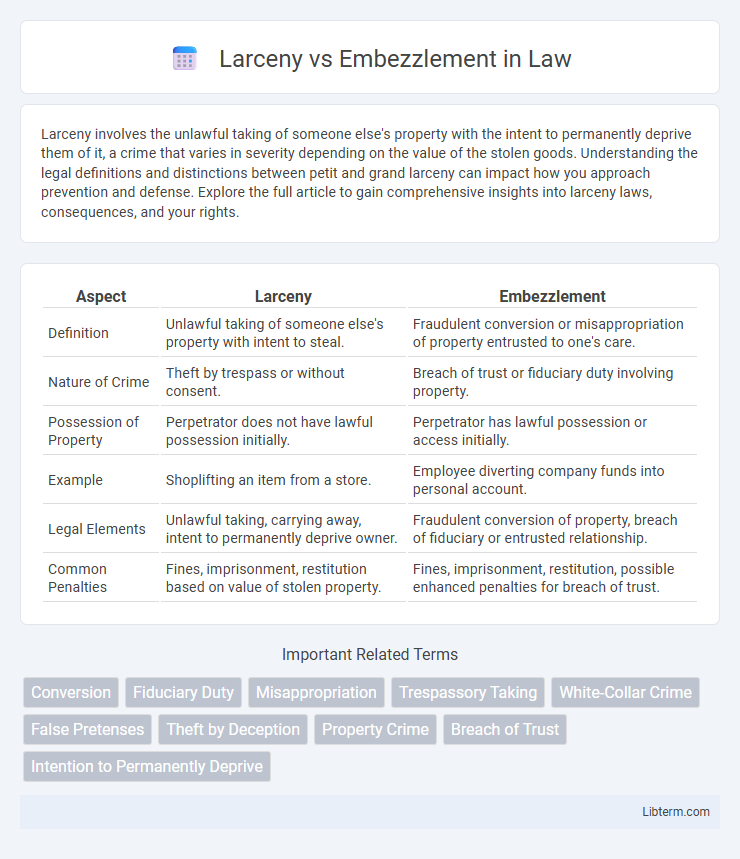Larceny involves the unlawful taking of someone else's property with the intent to permanently deprive them of it, a crime that varies in severity depending on the value of the stolen goods. Understanding the legal definitions and distinctions between petit and grand larceny can impact how you approach prevention and defense. Explore the full article to gain comprehensive insights into larceny laws, consequences, and your rights.
Table of Comparison
| Aspect | Larceny | Embezzlement |
|---|---|---|
| Definition | Unlawful taking of someone else's property with intent to steal. | Fraudulent conversion or misappropriation of property entrusted to one's care. |
| Nature of Crime | Theft by trespass or without consent. | Breach of trust or fiduciary duty involving property. |
| Possession of Property | Perpetrator does not have lawful possession initially. | Perpetrator has lawful possession or access initially. |
| Example | Shoplifting an item from a store. | Employee diverting company funds into personal account. |
| Legal Elements | Unlawful taking, carrying away, intent to permanently deprive owner. | Fraudulent conversion of property, breach of fiduciary or entrusted relationship. |
| Common Penalties | Fines, imprisonment, restitution based on value of stolen property. | Fines, imprisonment, restitution, possible enhanced penalties for breach of trust. |
Understanding Larceny: Definition and Key Elements
Larceny is defined as the unlawful taking and carrying away of someone else's personal property with the intent to permanently deprive the owner of it. Key elements include the physical taking, lack of consent, and the perpetrator's intent to steal, distinguishing it from other theft-related crimes. Understanding these elements is crucial to differentiate larceny from offenses like embezzlement, which involves the misappropriation of property entrusted to the offender.
What Constitutes Embezzlement?
Embezzlement constitutes the fraudulent appropriation of property or funds entrusted to an individual, typically occurring within a fiduciary or employment relationship. Unlike larceny, which involves unlawful taking without permission, embezzlement involves lawful possession followed by intentional misappropriation. Key elements include the lawful control of assets, a breach of trust, and the intent to permanently deprive the rightful owner of those assets.
Main Differences Between Larceny and Embezzlement
Larceny involves the unlawful taking and carrying away of someone else's property with the intent to permanently deprive them of it, typically without the owner's consent or knowledge. Embezzlement occurs when a person lawfully entrusted with property or funds fraudulently converts them for personal use, violating the trust of the owner or employer. The key difference lies in larceny's element of trespassory taking versus embezzlement's breach of fiduciary duty or trust.
Legal Criteria for Proving Larceny
Legal criteria for proving larceny include the unlawful taking and carrying away of another person's property with the intent to permanently deprive the owner of it. The prosecution must establish that the defendant exercised control over the property without the owner's consent and had a fraudulent intent at the time of the taking. Distinguishing larceny from embezzlement hinges on whether the property was unlawfully appropriated after lawful possession was obtained, with larceny requiring a trespassory taking.
Legal Criteria for Proving Embezzlement
Legal criteria for proving embezzlement require demonstrating that the accused had lawful possession or access to the property due to a fiduciary or employment relationship and subsequently misappropriated it for personal gain. Unlike larceny, where unlawful taking without consent is key, embezzlement hinges on a breach of trust and the fraudulent conversion of entrusted assets. Evidence must show intent to deprive the owner permanently and the violation of duties associated with the entrusted property.
Common Examples of Larceny Cases
Common examples of larceny cases include shoplifting, theft of personal property, and stealing unattended items such as bicycles or electronics. These offenses involve the unlawful taking of someone else's property with the intent to permanently deprive the owner of it. Unlike embezzlement, which typically entails the misappropriation of funds or assets by someone in a position of trust, larceny is characterized by direct theft without lawful possession.
Typical Scenarios of Embezzlement
Typical scenarios of embezzlement often involve employees misappropriating funds entrusted to them, such as accountants diverting company revenues into personal accounts or managers manipulating financial records to conceal theft. Embezzlement frequently occurs in corporate settings where individuals have authorized access to assets, enabling them to exploit their position of trust for personal gain. Unlike larceny, which usually involves the outright theft of property without consent, embezzlement is defined by the illegal conversion of legitimately obtained assets.
Potential Penalties and Consequences
Larceny and embezzlement carry distinct potential penalties that vary by jurisdiction, with larceny often classified as theft involving the unlawful taking of property, and embezzlement involving the fraudulent appropriation of assets by someone in a position of trust. Penalties for larceny can range from fines and restitution to imprisonment, depending on the value of stolen property and degree of the offense (petty or grand larceny). Embezzlement charges frequently result in harsher consequences due to the breach of fiduciary duty, including significant prison time, financial restitution, and potential civil liabilities.
Defenses Against Larceny and Embezzlement Charges
Defenses against larceny and embezzlement charges often revolve around disproving intent to steal, such as demonstrating lack of criminal intent or showing the property was rightfully possessed. Legal strategies include proving consent from the owner, establishing mistaken ownership, or presenting evidence of authorization to use or manage the assets in question. Strong defense arguments also emphasize procedural errors during investigation or violations of constitutional rights, which can lead to dismissal of charges.
Preventing Larceny and Embezzlement in the Workplace
Implementing strict internal controls and conducting regular audits are essential strategies for preventing larceny and embezzlement in the workplace. Employee training on ethical behavior and clear communication of company policies help reduce opportunities for theft and fraud. Leveraging technology such as surveillance systems and secure access controls further deters potential offenders and safeguards company assets.
Larceny Infographic

 libterm.com
libterm.com